Setting goals is one of the most fundamental parts of team management, yet it is often one of the most misunderstood. Too often, goals are set in annual planning meetings and never revisited or are handed down as broad statements that sound important but leave teams unsure of what to do next.
A study of 105 teams in the public sector found that “both goal clarity and self management positively affect team performance”. In other words, when teams know exactly what they are working toward and are given the freedom to execute, they consistently deliver better results.
This guide explains how to set team goals that are practical, focused, and designed for execution. You will find examples from real functions such as product, sales, and operations that show how high-performing teams translate strategy into everyday action.
Key Takeaways:
- Vague goals like “do better” don’t help teams move forward
- A good team goal is measurable, time-bound, tied to a business outcome, and within the team’s control
- Teams should define how they contribute to the broader strategy and focus on deliverables, not just effort
- Goals must be reviewed regularly using shared dashboards, 1:1s, and feedback tied to outcomes
- Common reasons for failure include lack of visibility, unclear ownership, and delayed feedback loops
- Real-world examples show how teams in product, sales, support, and finance translate strategy into action
What Makes a Good Team Goal?
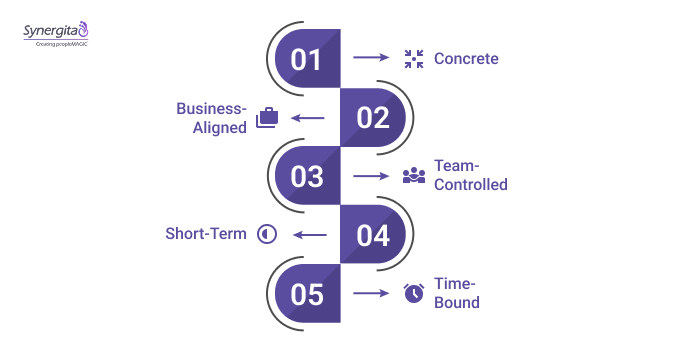
Team goals often fail not because teams lack intent but because the goals are either too broad or disconnected from execution. A goal like “improve communication” sounds useful but doesn’t tell the team what to do, how to track progress, or when to course-correct.
An effective team goal is:
- Concrete: “Publish two customer case studies per quarter” works better than “increase marketing content.” It tells the team exactly what output is expected.
- Tied to a business need: Goals should reflect what the company is trying to improve; whether it’s reducing churn, entering a new market, or cutting operational delays.
- Scoped to the team’s control: A finance team can’t own sales revenue, but they can aim for 100 percent on-time invoicing and tighter forecasting accuracy.
- Measurable in the short term: If you can’t tell whether the team is on track until year-end, the goal isn’t actionable. Good goals allow weekly or monthly check-ins.
- Time-limited with built-in review points: Deadlines drive focus, but regular reviews drive improvement. Set the timeframe and the cadence to revisit progress.
When goals are this specific, teams know what they are aiming for, how they’ll get there, and how to adjust if priorities shift.

Use the SMART Framework as a Baseline
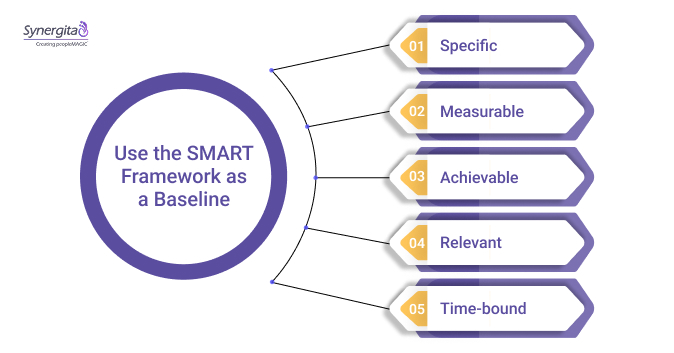
Before diving into the step-by-step process, it’s helpful to ground your team goals in the SMART framework. While it’s not a silver bullet, it provides a useful checklist for keeping goals outcome-oriented and achievable.
- Specific: Goals should be clearly defined with no room for ambiguity. Everyone on the team should interpret the goal the same way.
- Measurable: Define what success looks like with quantifiable metrics.
- Achievable: Ensure the goal is within reach given your team’s bandwidth and capabilities.
- Relevant: Align the goal with both the team’s function and a larger business priority.
- Time-bound: Attach a clear deadline or review cadence so progress can be evaluated regularly.
SMART isn’t a substitute for strategic thinking, but it ensures your team’s intent can actually translate into execution.
How to Set Effective Team Goals Step by Step
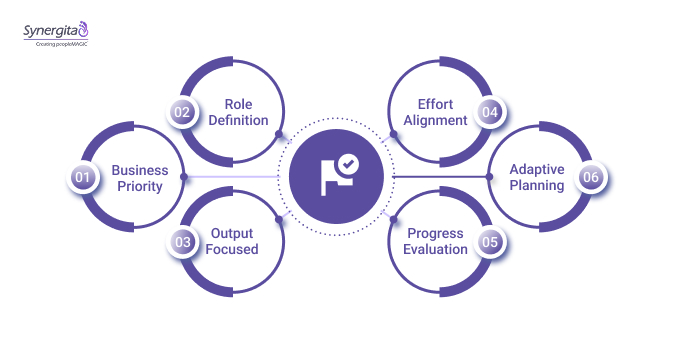
Setting team goals isn’t just about deciding what to aim for. It’s about designing the conditions that make success achievable and measurable. Here’s how to approach it in practice:
1. Start with the business priority: Begin by identifying the strategic outcome your team supports. Are you improving customer retention? Reducing delivery errors? Your team goal should anchor to that.
2. Define the team’s role in that outcome: Clarify how your team contributes. If the company wants faster feature rollouts, the design team might aim for shorter handoff cycles, while QA focuses on reducing regression time.
3. Make the goal output-based, not just activity-based: Focus on deliverables or measurable impact, not just effort. “Launch three internal training modules in Q3” gives more clarity than “work on employee enablement.”
4. Align individual efforts with the team goal: Once the goal is set, connect it to individual responsibilities. This reduces overlap and helps team members see where they contribute.
5. Decide how progress will be measured and reviewed: Choose metrics and checkpoints upfront. Whether it’s weekly check-ins or a shared dashboard, the review process should be clear before the work begins.
6. Build flexibility for course correction: Circumstances change. Teams need a way to adapt without losing sight of the original objective. Make space for realignment as part of the process.
Done well, this process turns team goals from a quarterly checkbox into a tool that helps teams stay focused, accountable, and aligned with business needs.
What Effective Team Goals Look Like in Practice
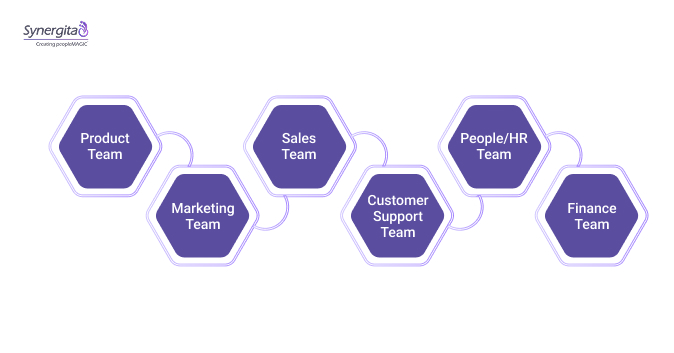
Telling teams to “do better” is not a goal. Yet, that’s what most targets sound like when they’re not scoped for action. Below are concrete examples from real functions; each one tied to a business priority, clearly measurable, and within the team’s control.
Product Team
- Business Priority: Increase user retention
- Team Goal: Cut onboarding drop-off from 38 percent to under 25 percent by simplifying mobile registration and tracking completion rates weekly
Marketing Team
- Business Priority: Generate qualified leads for enterprise plans
- Team Goal: Publish four customer case studies targeting enterprise buyers by Q3, with at least 1,000 pageviews and 5 SQLs per asset
Sales Team
- Business Priority: Shorten deal cycle for mid-market accounts
- Team Goal: Improve 30-day close rate from 42 percent to 55 percent by introducing pre-demo qualification steps and reviewing funnel weekly
Customer Support Team
- Business Priority: Improve first-contact resolution
- Team Goal: Resolve 85 percent of Tier 1 queries in the first response by deploying a new help desk script and tracking ticket outcomes in real time
People/HR Team
- Business Priority: Improve internal mobility
- Team Goal: Ensure 70 percent of mid-level roles are filled internally in 2025, supported by manager nominations and career check-ins logged in the system
Finance Team
- Business Priority: Improve forecasting precision
- Team Goal: Maintain a forecast accuracy rate within 5 percent variance for three consecutive quarters, tracked via monthly variance reports
Each of these goals gives the team something to own, track, and deliver; not just a metric to aim for. This is what moves a strategy from paper into execution.
How to Communicate Team Goals for Better Ownership and Execution
Even the most well-structured goals can fall flat if they are not communicated clearly. For goals to translate into consistent action, teams need more than visibility; they need context, ownership, and ongoing dialogue.
Poor communication often leads to misalignment, passive participation, or goals being viewed as “management-only” directives. On the other hand, well-communicated goals make teams feel involved, empowered, and accountable.
Here’s how to improve communication around team goals:
- Provide the ‘why’ behind every goal: Don’t just announce what needs to be done; explain how it connects to broader business outcomes. Teams are more likely to commit when they understand the reasoning behind the targets.
- Use visual formats to reinforce clarity: Present goals through dashboards, charts, or timelines. A goal that’s seen regularly is more likely to stay top of mind than one hidden in a planning document.
- Create shared ownership early on: Involve the team in defining milestones and success metrics where possible. This increases buy-in and helps surface practical challenges early.
- Use consistent language across tools and meetings: Terms like “lead quality,” “project completion,” or “resolution rate” should mean the same thing across departments. Standardizing terminology avoids confusion and wasted effort.
- Make space for goal-related discussions in 1:1s and stand-ups: Instead of treating goals as a quarterly event, build regular check-ins into your existing communication cadence.
When teams are looped into the goal-setting conversation; not just the results. They feel more ownership over the outcomes. And that’s when execution becomes consistent.
How to Track Team Goals for Better Execution
Most team goals don’t fail because of poor intent. They fail because no one’s tracking progress until it’s too late. Without regular check-ins, individual clarity, and tools to surface blockers, even well-set goals lose relevance fast.
Here’s how execution-focused teams make goal tracking a part of daily work; not just a quarterly ritual:
- Make weekly progress visible: Use shared dashboards to show current progress, blockers, and owner updates. Keep it simple; what was planned, what got done, what’s at risk. Teams that can see movement stay more focused and less reactive.
- Link feedback to goals: Recognize work that directly contributes to team outcomes. If someone improves support ticket resolution time, tie it to the customer satisfaction goal. Use structured feedback tools to log this, not just casual praise.
- Give managers a single view: A digital cockpit showing OKRs, timelines, check-ins, and skill gaps reduces blind spots. When team performance, engagement, and progress are visible on one screen, managers can act early. This also supports accountability without micromanagement.
- Include goal progress in 1:1s: Skip the vague “How’s it going?” Use specific prompts like “Where are we stuck on X?” or “What would help move Y forward?” Reviewing goals regularly keeps them top of mind and helps prevent misalignment.
- Use data to course-correct early: If a goal hasn’t moved in two check-ins, dig deeper. Is the target unrealistic? Are priorities shifting? Adjusting based on input and feedback is better than sticking to a broken plan.
Tracking is not just about metrics; it’s about maintaining direction, momentum, and relevance. When review systems are lightweight, integrated, and real-time, teams stay on track without burnout.

Why Team Goals Fail Even When Set Well
Even well-structured team goals can fall apart in execution. It’s not always due to poor planning. More often, failure stems from friction points that emerge during implementation.
Understanding these patterns can help teams anticipate risks and build processes to prevent goal derailment.
Common Challenges That Disrupt Goal Execution
- Lack of visibility: When teams lose sight of how daily work connects to the larger goal, motivation drops. This disconnect creates drift and silos.
- Unclear ownership: If no one is explicitly responsible for moving a goal forward, it gets buried under day-to-day tasks.
- Changing priorities with no re-alignment: Teams are agile, but their goals often aren’t. Shifting priorities without re-scoping leads to irrelevant or abandoned targets.
- Delayed feedback loops: If impact is only reviewed at quarter-end, it’s too late to adjust. Weekly feedback loops surface issues early.
- Tool overload: Spreading updates across Slack, email, spreadsheets, and dashboards makes it hard to know what’s current or relevant.
How to Spot Early Signs of Goal Fatigue
- Team members are unclear about where a project stands
- Check-ins feel like status reports, not action planning
- Goals are “carried forward” across quarters without completion
- Metrics are outdated or inconsistently tracked
- No feedback is linked to progress, only output
How Synergita Supports Goal Setting and Execution Across the Employee Lifecycle
Setting the right goals is only half the battle. Keeping them visible, relevant, and connected to performance outcomes is where most teams struggle. Synergita’s performance management suite is built to solve exactly this.
It helps organizations move from disconnected goal setting to a structured, data-driven approach that spans the full employee lifecycle.
1. Define and Cascade Goals with Clarity
- Set team and individual goals that align with strategic OKRs
- Break down department-level objectives into actionable sub-goals
- Use templates and goal libraries to reduce ambiguity and standardize practices across teams
2. Track Progress in Real Time
- Built-in OKR dashboards display goal status, metrics, and blockers at a glance
- Managers and teams can update progress weekly or monthly with notes and data
- Visual tracking helps prioritize interventions before issues escalate
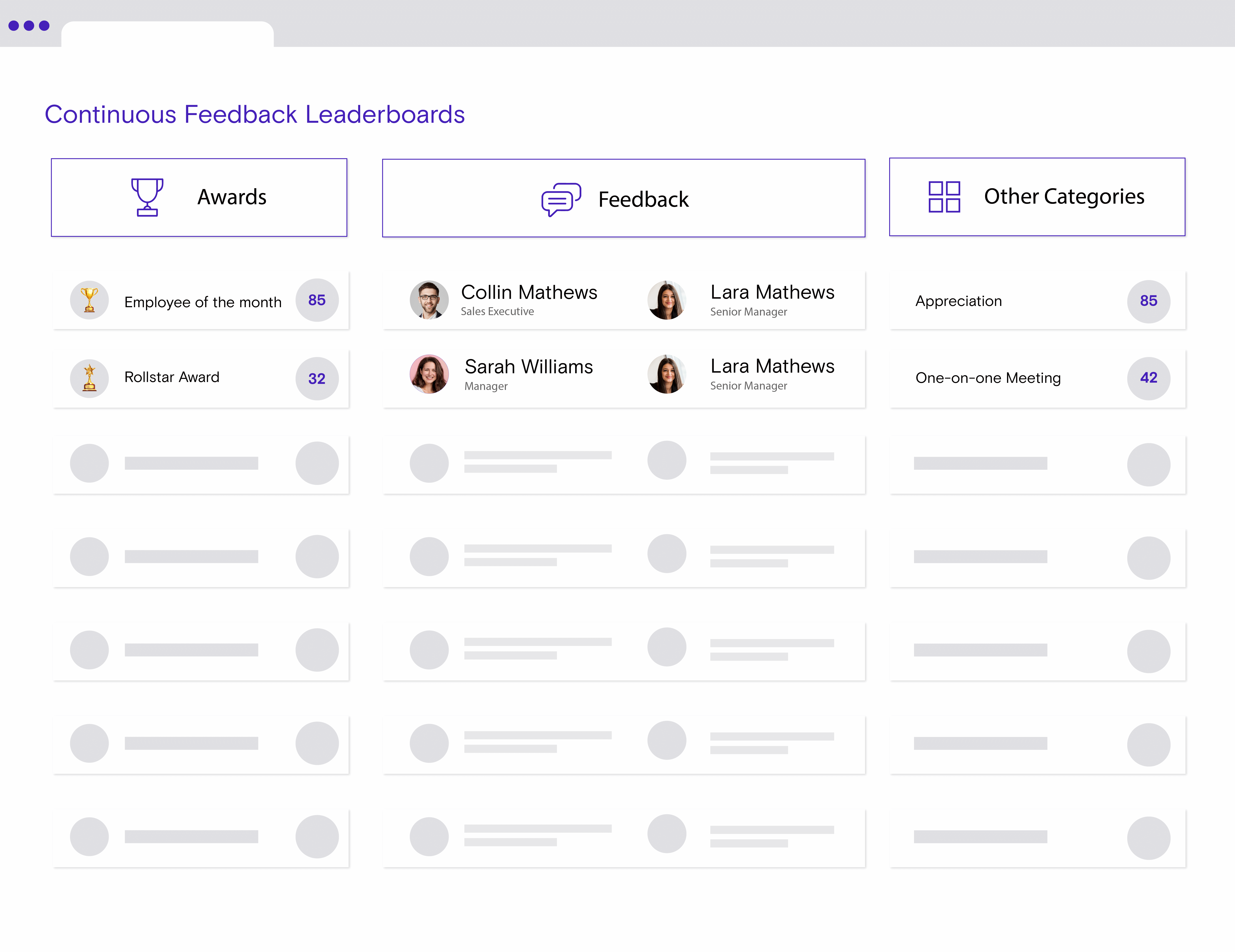
3. Tie Performance Reviews to Goal Outcomes
- Goals automatically sync with performance reviews, so evaluations reflect real contributions
- Customizable rating scales allow goal completion to weigh into appraisals
- Reduces bias by anchoring feedback in documented outcomes
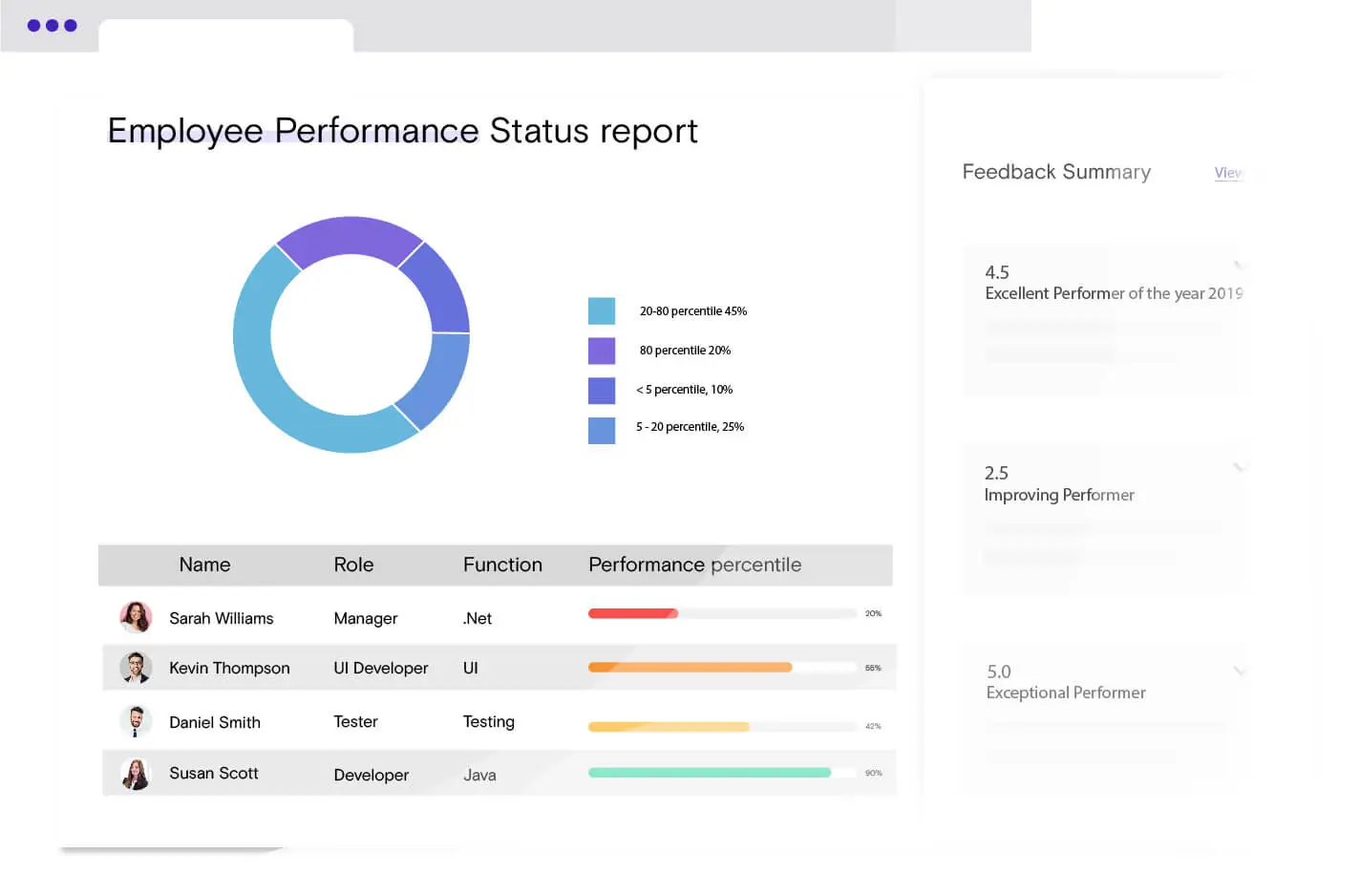
4. Drive Accountability with Continuous Feedback
- Tag feedback to specific goals or deliverables
- Recognize efforts aligned with team outcomes, not just effort
- Enable peer, upward, and manager feedback to foster shared ownership
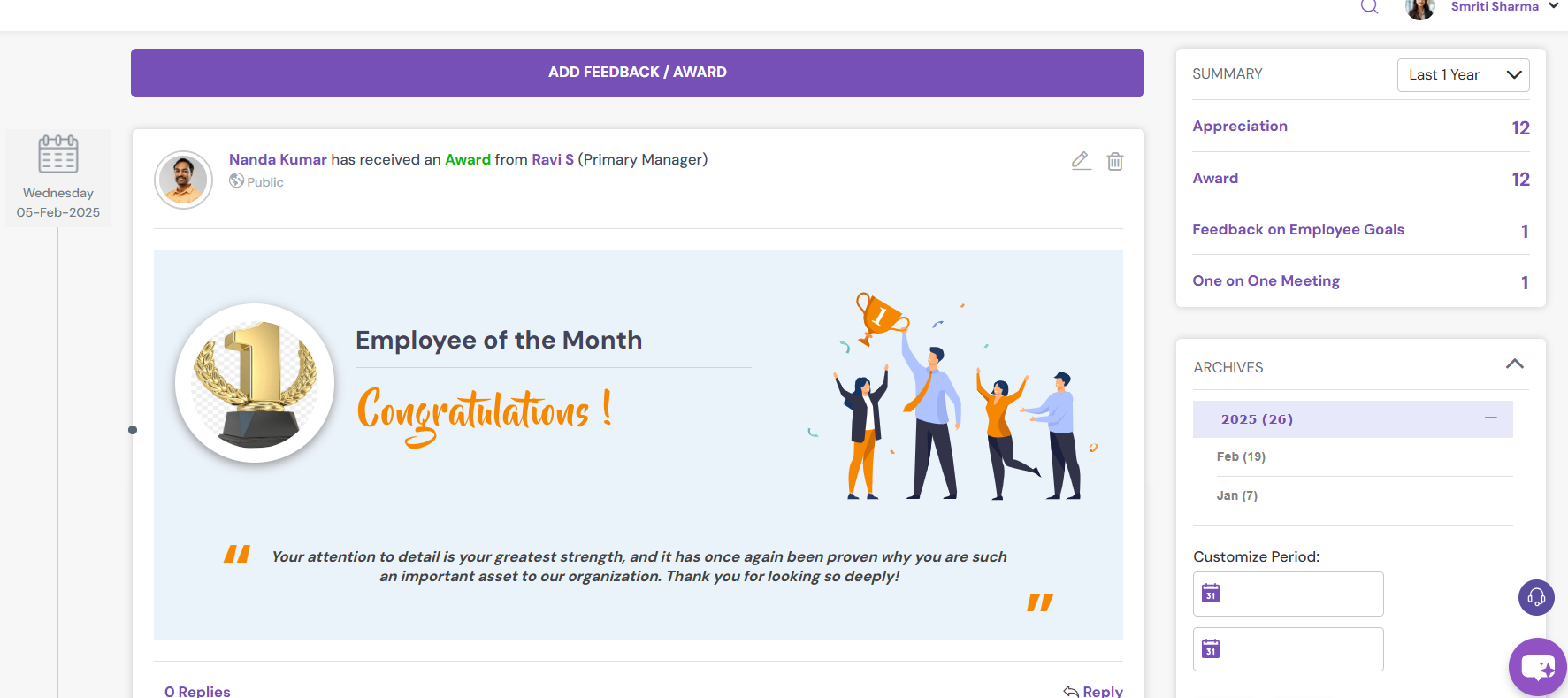
5. Stay Agile with Mid-Cycle Adjustments
- Goals can be edited or realigned if business priorities shift
- Changes are logged transparently for context and auditability
- Ensures teams don’t get locked into irrelevant targets
6. Enable Cross-Functional Goal Visibility
- View interdependencies and goal alignment across departments
- Collaborate on shared metrics (e.g., Sales and Marketing on lead conversion)
- Eliminate silos by building shared accountability around business outcomes
7. Close the Loop with Data-Driven Insights
- Track historical goal trends, bottlenecks, and performance patterns
- Use analytics to improve goal-setting quality quarter over quarter
- Identify teams or roles that consistently over or underdeliver for proactive coaching

Whether you’re running OKRs, KPIs, or custom goal frameworks, Synergita makes it easy to align goals with real performance and ensure they remain visible, flexible, and meaningful.
Set and Track Goals That Deliver Results
Most teams don’t fail because of lack of effort. They fail because the goals they are chasing are unclear, outdated, or disconnected from outcomes. When you combine goal-setting discipline with the right tools, performance stops being a guess and becomes a pattern.
Synergita helps teams set better goals, track what matters, and connect execution to business impact. If you want your next quarter to be driven by clarity, accountability, and results, it starts with how you define and follow through on your goals.
Ready to see how Synergita can help? Request a demo today and build goals your teams can actually deliver on.

Frequently Asked Questions
Q: What are some good goals for a team?
Ans: Good team goals are tied to specific business outcomes and within the team’s control. Examples include reducing onboarding drop-off, improving forecast accuracy, or increasing first-contact resolution in support. The more specific and measurable the goal, the more likely it is to succeed.
Q: What is the best team goal?
Ans: There is no universal best team goal. The best goal depends on your business priority. For example, if your focus is customer retention, a strong team goal might be to reduce churn by improving support resolution time or onboarding flow.
Q: What is your team’s goal?
Ans: Your team’s goal should reflect its unique function and contribution. If you’re in marketing, it could be tied to lead generation. If you’re in operations, it could focus on reducing process delays. Use OKRs or SMART goals to define it clearly.
Q: What are the 5 SMART goals?
Ans: SMART stands for Specific, Measurable, Achievable, Relevant, and Time-bound. These five attributes ensure a goal is actionable and trackable. For example: “Increase product demo bookings by 25 percent in Q2” checks all five boxes.
Q: What are the 7 SMARTER goals?
Ans: SMARTER builds on SMART by adding Evaluated and Reviewed. This means regularly checking progress and adjusting when needed. It’s especially helpful for dynamic teams working in fast-paced environments.

